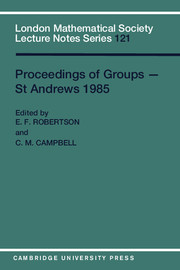Book contents
- Frontmatter
- Contents
- Introduction
- Photograph
- 1 Automorphisms of solvable groups, Part I
- 2 Automorphisms of solvable groups, Part II
- 3 A survey of groups with a single defining relation
- 4 Some algorithms for computing with finite permutation groups
- 5 Five lectures on group rings
- 6 Buildings and group amalgamations
- 7 Finite presentability of S-arithmetic groups
- 8 Efficient presentations of GL(2, ℤ) and PGL(2, ℤ)
- 9 The commutator map
- 10 Polynomial functions and representations
- 11 On questions of Brauer and Feit
- 12 The Picard group and the modular group
- 13 Factor groups of the lower central series of free products of finitely generated abelian groups
- 14 Lattice ordered groups - a very biased survey
- 15 Totally orthogonal finite groups
- 16 One-relator products of groups
- 17 The Cavicchioli groups are pairwise non-isomorphic
- 18 Congruence and non-congruence subgroups of the modular group: a survey
- 19 Small cancellation theory with non-homogeneous geometrical conditions and application to certain Artin groups
- 20 The Lie algebra associated to the lower central series of a group
- 21 Algebraically closed locally finite groups
- 22 On power-commutative and commutation transitive groups
- 23 Dimension function for discrete groups
- 24 Coset graphs
- 25 Nilpotent quotient algorithms
- 26 Generators of p-groups
- 27 On the matrix groups associated to the isometries of the hyperbolic plane
- 28 A characteristic subgroup of N-stable groups
- 29 The isomorphism problem for integral group rings of finite nilpotent groups
- 30 Embedding the root group geometry of 2F4(q)
- 31 On generalized Frobenius complements
- 32 Subgroups of finite index in soluble groups: I
- 33 Subgroups of finite index in soluble groups: II
- 34 Some interconnections between group theory and logic
- 35 Groups covered by abelian subgroups
- 36 Embeddings of infinite permutation groups
- 37 Maximal subgroups of sporadic groups
13 - Factor groups of the lower central series of free products of finitely generated abelian groups
Published online by Cambridge University Press: 05 March 2012
- Frontmatter
- Contents
- Introduction
- Photograph
- 1 Automorphisms of solvable groups, Part I
- 2 Automorphisms of solvable groups, Part II
- 3 A survey of groups with a single defining relation
- 4 Some algorithms for computing with finite permutation groups
- 5 Five lectures on group rings
- 6 Buildings and group amalgamations
- 7 Finite presentability of S-arithmetic groups
- 8 Efficient presentations of GL(2, ℤ) and PGL(2, ℤ)
- 9 The commutator map
- 10 Polynomial functions and representations
- 11 On questions of Brauer and Feit
- 12 The Picard group and the modular group
- 13 Factor groups of the lower central series of free products of finitely generated abelian groups
- 14 Lattice ordered groups - a very biased survey
- 15 Totally orthogonal finite groups
- 16 One-relator products of groups
- 17 The Cavicchioli groups are pairwise non-isomorphic
- 18 Congruence and non-congruence subgroups of the modular group: a survey
- 19 Small cancellation theory with non-homogeneous geometrical conditions and application to certain Artin groups
- 20 The Lie algebra associated to the lower central series of a group
- 21 Algebraically closed locally finite groups
- 22 On power-commutative and commutation transitive groups
- 23 Dimension function for discrete groups
- 24 Coset graphs
- 25 Nilpotent quotient algorithms
- 26 Generators of p-groups
- 27 On the matrix groups associated to the isometries of the hyperbolic plane
- 28 A characteristic subgroup of N-stable groups
- 29 The isomorphism problem for integral group rings of finite nilpotent groups
- 30 Embedding the root group geometry of 2F4(q)
- 31 On generalized Frobenius complements
- 32 Subgroups of finite index in soluble groups: I
- 33 Subgroups of finite index in soluble groups: II
- 34 Some interconnections between group theory and logic
- 35 Groups covered by abelian subgroups
- 36 Embeddings of infinite permutation groups
- 37 Maximal subgroups of sporadic groups
Summary
INTRODUCTION
This paper deals with the factor groups of the lower central series of a certain class of groups to be defined below. For a free group F of finite rank, the structure of the factor groups Fn</sub\≥Fn/Fn+1, where Fn denotes the nth subgroup of the lower central series of F is well known [5,9].
The lower central series is important in several applications. For example, such quotient groups arise in the study of grammars [10] and are also important in Burnside's problem [7,8]. This being the case, it seems desirable to determine the structure of these factor groups for other classes of non-free groups.
Here we shall study the factor groups of the lower central series arising from groups G through the use of basic commutators. We shall assume that G is a free product of finitely many groups, G(i), and that every G(i) is a finitely generated abelian group. As such this paper continues and generalizes the work of Dark [2], Struik [11,12] and the authors [15,16,17]. We will give an algorithm for finding bases of the factor groups of the loweT central series of our groups, G, thus extending the results of Theorem 2.1 of [3]. This algorithm is based on the “representation algorithm” of [17].
- Type
- Chapter
- Information
- Proceedings of Groups - St. Andrews 1985 , pp. 164 - 203Publisher: Cambridge University PressPrint publication year: 1987



